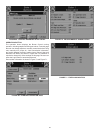
57
Note: The system time can be set in the OI display to ensure that
correct timestamps are given to the controls’ lockouts and alerts.
Power interruptions will require the time to be reset as the display
DOES NOT have a time backup means.
The Clear Lockout button allows the user to acknowledge and
clear (reset) the lockout when in lockout state, much the same
as pressing the reset button on the front of the Burner Control.
The user can toggle between displaying the controls’ lockout
history and alert log by pressing the Alerts or Lockouts button on
the bottom of the pages.
To see additional detail about a lockout or alert, touching on the
lockout or alert in the list expands the view of that lockout or alert,
as shown in Figure 65 and Figure 66.
This History dialog box provides an exploded view of the status
information displayed in the History button (the font is larger).
One of the four buttons (OK, Lockouts, Alerts, or Silence) can
be selected. If none of these buttons are selected the dialog box
closes after 30 seconds.
Two types of historical data can be displayed on the history page:
lockout history and alert log.
The entire 15 fault code history is displayed in a scrollable list
with the most recent fault displayed rst followed by the next
most recent fault. Summary information is displayed for each
fault entry, including the burner cycle count, fault code, and fault
number with description. Detailed information for a specic fault
entry that also includes burner control sequence state, burner
run-time hours, annunciation status, etc., is viewed by selecting
(touching the History line) the lockout entry in the list.
The date and time that each fault occurred is displayed in the
lockout history. The lockout timestamp displays in both the
lockout summary and detail information.
The Burner Control does not maintain date or time of day
information. The date and time stamp is assigned by the OI
display. When the OI display rst obtains the lockout and alert
history from the control (during the display data synchronization),
no timestamps are assigned since the times that the lockouts
occurred are unknown. All new lockouts that occur after the
synchronization are assigned timestamps.
FIGURE 64. EXAMPLE OF HYDRONIC HISTORY
FIGURE 65. EXAMPLE OF LOCKOUT HISTORY
FIGURE 66. EXAMPLE OF ALERT SHOWN
FIGURE 67. CONTROL EXPANDED LOCKOUT DETAIL


















